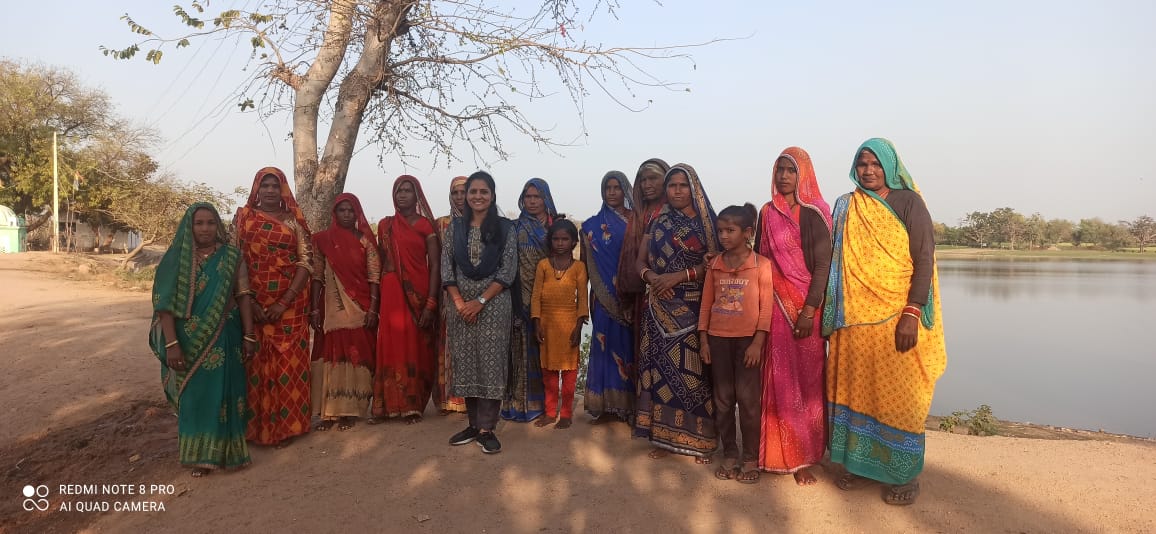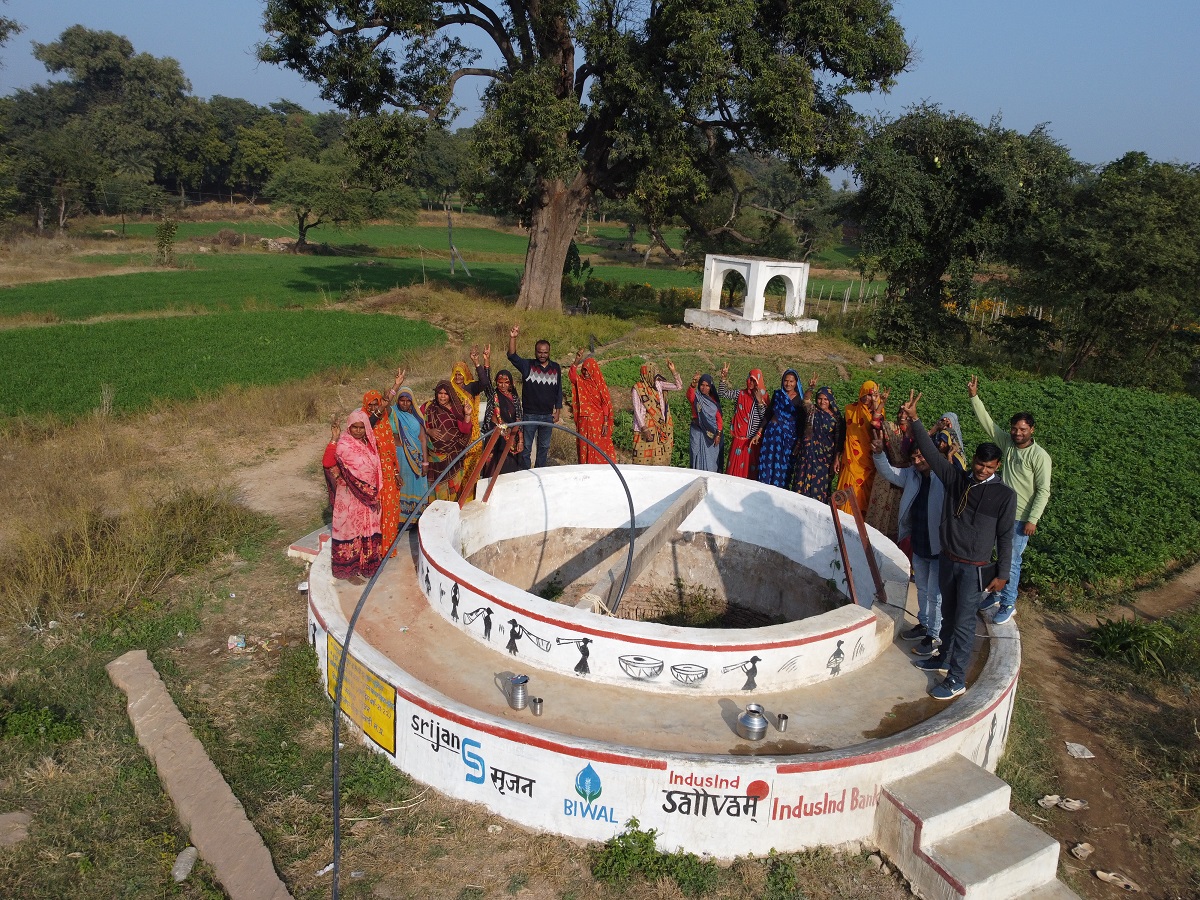
Most of them are very small farmers, owning one to three acres of land or even less, yet the work they have taken up is not small, it is big. This work is mostly related to strengthening sustainable farming and water conservation.
As Girija Devi explains, these efforts started with getting together and holding regular meetings to discuss development problems and challenges. One of the first initiatives to emerge from these was to arrange for the removal of a part of the accumulated silt of several years from the main village tank. A voluntary organization SRIJAN helped with the heavier desilting work, taken up as a part of a wider effort BIWAL (Bundelkhand Initiative for Water, Agriculture and Livelihoods), farmers made their own arrangements to carry the much in demand fertile silt to their fields. Women played an important part in ensuring that the entire work could proceed in a just and hassle-free way.
While this helped to increase the fertility of farms, perhaps an even bigger contribution was made to increasing the water holding and conservation capacity of the water tank. As more rain water collected and stayed in the tank for a longer time, this led to more direct irrigation and, what is even more important, to better recharge. There was now more water in the wells and hand pumps. Drinking water situation improved for villagers as well as for animals, bringing much relief to women who have to bear much of the water responsibilities in the household.
The water situation including recharge further improved with 15 pits (called dohas) dug in a water channel, in a well-measured way and at places identified carefully by the community. Innovative tree planting and bunds further added to water conservation.
This was followed up by sustained efforts to shift from a fertilizer-pesticide system with little diversity to a very different system based on natural/organic farming with immense biodiversity, this change led by women farmers. Several farmers have more or less completed this shift, while some more are in the process of doing so, carefully trying the new system on a part of their land first before covering their entire land with this. This change is taking place in conditions of free well-informed choice, with a lot of discussion among farmers and with SRIJAN activists, and therefore the rapid strides made by natural farming speaks a lot for genuine acceptance of natural farming by small farmers without anything being imposed.
In my group discussion with women farmers, they spoke very enthusiastically about the productivity gains they have achieved on several farms, and even where these have not yet been realized at least the production has not declined while expenses (earlier incurred on expensive, entirely market purchased chemical pesticides and chemical fertilizers) have definitely declined, and the health and nutrition quality of food produced on their farms has definitely increased.
Several farmers have moved over entirely to natural farming based on making better scientific use of locally available cow dung and urine. Ram Kunwar has established a natural farming center on her farm where she stores extra quantity of cow dung and urine-based manure as well as pest repellant for those farmers who need it, at a low and affordable price.

What appears to enthuse women farmers most is scientifically practiced vegetable farming on small plots of land, including kitchen gardens. Some women are playing a prominent role in the entire chain from preparing manure to planting to marketing to preserving seeds for the next crop. As many as 15 or even more vegetables are being grown on small plots of land, contributing much to family nutrition and cash earnings. The main principle is to plant various vegetable plants in such a way that these tend to be protective and helpful towards each other’s growth. Hence plants which need shade are grown under a bigger, taller plant while those creeper vegetables which need more exposure to sun are given the support of bamboos and wires to remain in the top layer of the garden. Similarly, orchards with local fruits like papaya, mango, guava and lemon are being grown following a similar pattern.
Gayatri says that some farms have even been able to almost double their production. An elderly woman says that millets like kodon, sawan and cheena were very useful and will be revived now. Srijan activist Mamta says that this village has many ‘lead’ natural farmers who are already committed to various aspects of natural farming and they in turn are helping ‘associate’ natural farmers to progress further in this direction.
With several demonstration plots of natural farming spread across the village, it is humming with tunes of various ecologically protective changes. This is best captured in group meetings of women farmers where women farmers are full of enthusiasm and creative ideas.
These efforts have extended further to several other villages of Niwari district, helped by a generous grant from Indus Ind Bank. In Gulenda village of Prithvipur block several of these activities are almost equally visible, while the water conservation effort here has been particularly impressive. The water tank here has been not just desilted but also repaired, a well has also been renovated and pits or dohas in water channel have contributed much to water recharge. These efforts have helped to reduce the dependence on migration. In Bahera village of Niwari block, the 22 dohas created in water channels have given very encouraging results. Changes in these and a few other villages of Niwari district are attracting farmers in other villages as well and deserve wider support, with key elements being water conservation and natural farming with special emphasis on smaller farmers and women farmers.
The writer is Honorary Convener, Campaign to Save Earth Now. His recent books include India’s Quest for Sustainable Farming and Healthy Food, Planet in Peril, Man over Machine and Hindi Cinema and Society.
Related:
Three women farmers die in road accident at Tikri border
Women farmers, students write open letter against SC’s comment on women farmers
Women farmers worst hit by anti-farmer laws: National Women’s Organisations